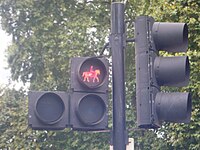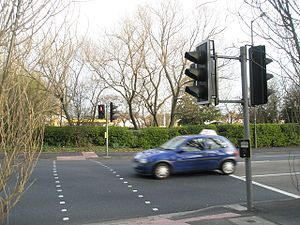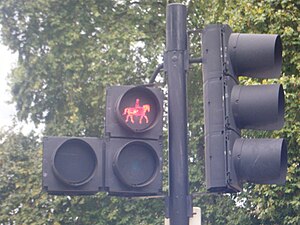Key:crossing ref: Difference between revisions
(Images added) |
m (note added) |
||
| Line 13: | Line 13: | ||
|statuslink=https://wiki.openstreetmap.org/w/index.php?oldid=132309 |
|statuslink=https://wiki.openstreetmap.org/w/index.php?oldid=132309 |
||
}} |
}} |
||
{{Ambox|type=caution|text={{Tag|crossing_ref}} is only related to how crossing is controlled by traffic lights or sings. It is not related to {{wikipedia|en|Road surface marking|text=no}}}} |
|||
=== See also === |
=== See also === |
||
Revision as of 08:22, 23 March 2022
| Description |
|---|
| Used to reference a specific type of crossing markings. |
| Group: crossings |
| Used on these elements |
| Documented values: 2 |
| Requires |
|
| Useful combination |
|
| Status: approved |
| Tools for this tag |
|
|
crossing_ref=* is only related to how crossing is controlled by traffic lights or sings. It is not related to |
See also
Common values
pxo(pedestrian crossover with or without flashing lights (Canada)
| Tag | Description | Image |
|---|---|---|
| crossing_ref=zebra | A zebra crossing is a controlled pedestrian crossing without traffic signals. Intermittent white stripes are painted across the carriageway at the crossing as well as Belisha beacons on either side of the road. Zig-Zag markings are used on approach and exits of the crossing. Pedestrians have priority over road traffic.
Where a zebra crossing crosses a cycle track, zig zag markings & Belisha beacons can be omitted, pedestrians have priority over cyclists. |
|
| crossing_ref=tiger | A tiger crossing is a controlled pedestrian & cycle crossing without traffic signals. A zebra crossing is provided with an adjacent cycleway crossing directly parallel to it (marked by cycle symbols & large square markings on the edge). Belisha beacons and Zig Zag markings are provided the same as a Zebra Crossing. Both Pedestrians and Cyclists have priority of road traffic on the main carriageway.
In initial trials they were called Tiger crossings due to using yellow stripes instead of white, however become known as "Parallel crossings" in Law. It is proposed to change this tag to crossing_ref=parallel due to the old term of "tiger" not being used in legislation or design. |
|
| crossing_ref=pelican | A pelican crossing is a traffic signal controlled pedestrian crossing. These are an older design of pedestrian crossing in the UK which only legacy installations still exist from pre-2004. They always feature far-side signals for pedestrians, with the near-side push button units (PBUs) displaying text lit up with "WAIT" when the button is pushed, along with instructions on how to use the crossing. Pelican crossings do not use sensors to detect when the crossing is clear of pedestrians, instead using a flashing amber light for road traffic when they need to give way to pedestrians crossing the road, or continue if there are no pedestrians crossing. Zig zag markings are always provided, except when the crossing is part of a junction. | |
| crossing_ref=puffin | A puffin crossing is a traffic signal controlled pedestrian crossing. These are the newer types of pedestrian crossing in the UK. They have additional sensors which can detect when pedestrians are waiting to cross, and to see when they are on the crossing, making the crossing safer and more efficient.
They usually have near-side signals shown on the side traffic first approaches from, making pedestrians look at traffic instead of across, this also means that pedestrians will not see the light change to red whilst they are on the crossing. Some puffin installations (mostly in London) still use far-side signals at busy crossings where it may not be easy for all pedestrians to see a near-side indicator. Zig zag markings are always provided, except when the crossing is part of a junction. |
|
| crossing_ref=toucan | A toucan crossing is a traffic signal controlled pedestrian & bicycle crossing. These are a variation of pelican OR puffin installations which allow bicycles to cross as well as pedestrians. Newer installations will have near-side indicators (like puffin), while some older installations will have far-side (like pelican). On Near-side units they display both a red or green bicycle alongside a red or green pedestrian, while on far-side they will only show a green bicycle. Zig zag markings are always provided, except when the crossing is part of a junction. | |
| crossing_ref=pegasus | A pegasus crossing is a traffic signal controlled horse crossing. These are a variation of pelican OR puffin installations which allow horse rider (either mounted or dismounted) to crossing. Like toucan crossings these can have either near side or far side signals, but Pegasus crossings are not combined with pedestrians or bicycles, which means they will also show a red or green horse. Pegasus crossings usually have a Toucan provided adjacent to them for pedestrians and cyclists to use. Zig zag markings are always provided, except when the crossing is part of a junction. |
As of 2021, highway=crossing crossing_ref=hawk is the most commonly used tag for a HAWK beacon, a relatively new kind of crossing in the United States that uses standard road markings and pedestrian signals but a unique signal directed at motorists. [1][2][3][4]
Examples and Proposals
- Examples see: Key:crossing#Examples
- Proposal 2008: approved - Road crossings earlier reference to
crossing_refsubkey - Proposal 2018: proposed - Wiki page proposal and discussion







